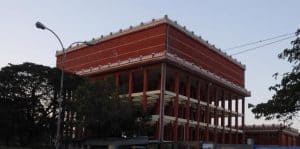As the city gears up for celebrations of Madras Day (or Week), like every year I go back in my own time machine to reminisce about the city and in particular my locality. Fortunately, I have been living in the same locality – intersection of Anna Nagar West and Villivakkam – since my school days and have seen the rapid development and transformation of both areas.
Long before 100 Feet Road became the link to all parts of the city, I remember casually hopping across this road to reach my school. The other prominent road was the New Avadi Road, that connected us to the other side of the city. There were two significant landmarks near our area, the Integral Coach Factory and the English style red building, housing the Kilpauk Water Works. For some reason, I still love calling it the red building.
The first water treatment plant
The red building has a place in the history of Madras that not many are aware of. Honestly, till last year, even I had only been giving it a ‘wow!’ look, and had not thought about its significance or its history. It was only after I read about it, that its true importance to the city became clear.
Here was the first water treatment plant built for what was then Madras, with a capacity of 80 million litres per day, which of course speaks of the engineering excellence that went into it. But there are other interesting and lesser known facets of the building that are equally fascinating.
The Kilpauk water treatment plant was inaugurated in 1914. A massive 60 foot steel tank at the entrance is as old as the red building itself. The 6.8 million-litre overhead tank supplied water to the city until last year, when its operations were shut down citing structural instability. There is also a second overhead water tank which was built in 1966. A high tension pump installed in 1936 still functions tirelessly, supplying treated water to Chennaiites.
The purification technology that was in use till as late as 2000, was the age-old one, using fine sand, pebbles and bricks. As demand increased, this system was replaced by one that used chemicals along with rapid sand filter technology.
A 177-ft chimney stands tall near the sand filter structure. This chimney was used to let out the smoke that came from the coal-fed steam engines.
Several structures have come up in later years but they were all carefully planned to resemble the heritage red building.
So is the Kilpauk water plant building yet another piece of the grand construction legacy of our erstwhile colonial rulers? Well yes, but there is a strong Indian connection too.
The Indian behind this piece of history
History records that special engineer J W Madeley pioneered the water treatment system. But history, as we know, is often a blend of documented and hidden realities, and this is no exception too. The work of an Indian, Hormusji Nowroji, that went into the building of the Kilpauk Water Works, is rarely talked about but definitely needs to be acknowledged. Historian V Sriram in his blog has recorded the significant contribution of Nowroji and says that he should be referred to as the ‘father of piped water supply’ to the city.
A Parsi, Nowroji graduated from the College of Engineering, Guindy. He was in fact the first Indian to be promoted to the post of Engineer at the Corporation, and was the Sanitary Engineer to the Government of Madras. He was part of the committee that worked on the Water Works Project, and also worked with the famed Colonel John Pennycuick, the father of the Mullaiperiyar Dam.
The British, however, hesitated to place an Indian engineer at the helm of such a critical and prestigious project, and hence, J W Madeley was appointed Special Engineer, with a team reporting to him, that included Nowroji. Nowroji, however, was almost solely responsible for the works until 1912, when he retired prematurely.
It is only fitting to remember and pay our tributes to this Indian this time of the year, as we celebrate Madras Week. As we dig more to know about the heritage and culture of Madras, who knows? We might end up discovering more such individuals who have played a critical role in shaping the city and life in it.
